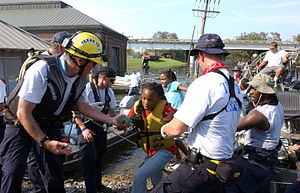
Back Urban Search and Rescue German Rauniopelastus Finnish Sauvetage-déblaiement French Pencarian dan penyelamatan perkotaan ID USAR Italian Urban søk og redning NB Муниципальная служба спасения Russian Urban sök och räddning Swedish การค้นหาและกู้ภัยในเขตเมือง Thai
The examples and perspective in this article deal primarily with the United States and do not represent a worldwide view of the subject. (December 2010) |


Urban search and rescue (abbreviated as USAR[1] or US&R[2]) is a type of technical rescue operation that involves the location, extrication, and initial medical stabilization of victims trapped in an urban area, namely structural collapse due to natural disasters, war, terrorism or accidents, mines and collapsed trenches.
The causes of USAR incidents can be categorised as accidental and deliberate.
Structural collapse incidents can comprise unstable or collapsed structures in an unsafe position. Usually collapse incidents leave voids inside the debris that can result in numerous casualties trapped under large amounts of very heavy and often unstable debris.
USAR services can be faced with complex rescue operations within hazardous environments. Incidents experience shows that people are often found alive many hours and days after rescue operations commence, and the corresponding services should be planned accordingly.
USAR teams in different countries may be organised in a variety of ways, but they are often associated with firefighting services.[3]
The increasingly complex methods and procedures, and the modern ability to bring in teams from far afield has brought a very strong drive for standardization within nations and internationally, most obvious in the role of the United Nations' International Search and Rescue Advisory Group (INSARAG) in large natural disasters.[4]
Urban search-and-rescue is considered a multi-hazard discipline, as it may be needed for a variety of hazards including earthquakes, cyclones, storms and tornadoes, floods, dam failures, technological accidents, terrorist activities, and hazardous materials releases.
- ^ The abbreviation USAR has been adopted by the UN’s International Search and Rescue Advisory Group (INSARAG) to signify an Urban Search and Rescue team all over the world regardless of the language spoken.
- ^ In the US due to legal issues involving potential confusion with the United States Army Reserve
- ^ E.g. English fire and rescue services are required by law to deal with "an emergency involving the collapse of a building or other structure". Section 3 of The Fire and Rescue Services (Emergencies) (England) Order 2007.
- ^ "United States Response to the Earthquake in Bam, Iran", coe-dmha.org